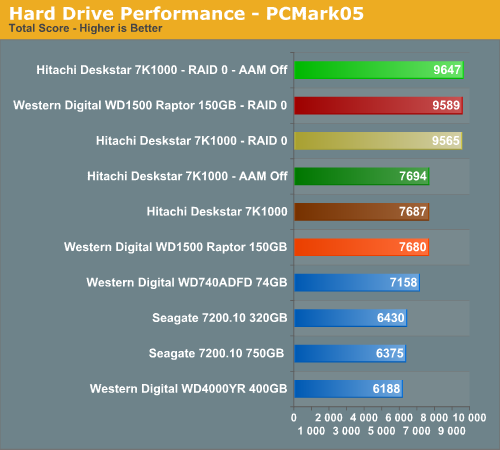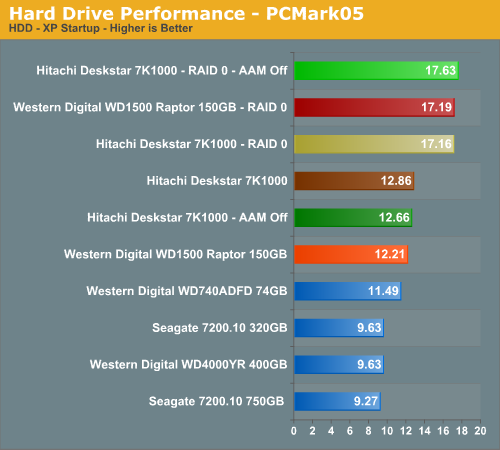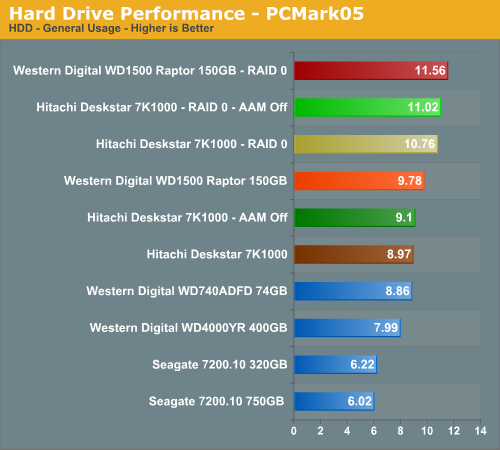Hitachi Deskstar 7K1000 in RAID 0: Is Two Terabytes really better than One?
by Gary Key on April 19, 2007 12:15 AM EST- Posted in
- Storage
Hard Disk Performance: PCMark05
We are utilizing the HDD test suite within PCMark05 for further comparative hard disk scores as it provides a mixture of actual application results and specific read/write percentages utilized within these programs. It is also a readily available benchmark that others can use for comparative purposes. The program utilizes the RankDisk application within the Intel iPeak SPT suite of tools to record a trace of disk activity during usage of real world applications. These traces are then replayed to generate performance measurements based upon the actual disk operations within each application. The HDD test suite contains 53% read and 47% write operations with each trace section utilizing varied amounts of read or write operations. Additional information about the test suite can be found in PDF format here PCMark05 whitepaper.
The PCMark05 test results are based upon the following trace runs:
Windows XP Startup: This test consists of 90% reading and 10% writes that tracks XP activities at start-up.
Application Loading: This test consists of 83% reading and 17% writes that tracks the opening and closing of the following programs.
File Write: This test consists of 100% write activities by writing 680MB of files onto the hard disk.






Our PCMark05 RAID 0 results show a 25% improvement over the single Hitachi drive results. The 7K1000 combination still scores better than the WD 150GB Raptor setup in this benchmark provided AAM is turned off, although the differences are minor. The major performance delta between the 7K1000 single and RAID 0 configuration is in the Windows Startup and File Write tests. As a side test that we are still developing, we tracked our actual XP startup times with each configuration. The RAID 0 setups only improved startup times by a few tenths of a second in most cases.
We fully expected the File Write tests to show major improvements as this is an area where RAID 0 will show an advantage. We see minor differences occurring in the General Usage and Application Loading sections of the test where write and read operations are balanced to a certain degree.
The Raptor's superior rotational/access speeds allow it to basically score slightly better than the 7K1000 except in the Virus Scan test where the 7K1000 has exceptional scores, even though it still lags behind the Seagate drive. Overall, if you need to improve your PCMark05 benchmark scores then RAID 0 will certainly do that, but as evidenced in the General Usage and Application results which mimic actual applications there is minimal impact.
We are utilizing the HDD test suite within PCMark05 for further comparative hard disk scores as it provides a mixture of actual application results and specific read/write percentages utilized within these programs. It is also a readily available benchmark that others can use for comparative purposes. The program utilizes the RankDisk application within the Intel iPeak SPT suite of tools to record a trace of disk activity during usage of real world applications. These traces are then replayed to generate performance measurements based upon the actual disk operations within each application. The HDD test suite contains 53% read and 47% write operations with each trace section utilizing varied amounts of read or write operations. Additional information about the test suite can be found in PDF format here PCMark05 whitepaper.
The PCMark05 test results are based upon the following trace runs:
Windows XP Startup: This test consists of 90% reading and 10% writes that tracks XP activities at start-up.
Application Loading: This test consists of 83% reading and 17% writes that tracks the opening and closing of the following programs.
- Microsoft Word
- Adobe Acrobat Reader
- Windows Media Player
- 3Dmark 2001SE
- Leadtek WinFast DVD
- Mozilla Internet Browser
- Opening a Microsoft Word document, performing grammar check, saving and closing
- Compression and decompression using WinZip
- Encrypting and decrypting a file using PowerCrypt
- Scanning files for viruses using F-Secure Antivirus
- Playing an MP3 file with Winamp
- Playing a WAV file with Winamp
- Playing a DivX video using the DivX codec and Windows Media Player
- Playing a WMV video file using Windows Media Player
- Viewing pictures using Windows Picture Viewer
- Browsing the Internet using Microsoft Internet Explorer
- Loading, playing and exiting a game with Tom Clancy's Ghost Recon
File Write: This test consists of 100% write activities by writing 680MB of files onto the hard disk.






Our PCMark05 RAID 0 results show a 25% improvement over the single Hitachi drive results. The 7K1000 combination still scores better than the WD 150GB Raptor setup in this benchmark provided AAM is turned off, although the differences are minor. The major performance delta between the 7K1000 single and RAID 0 configuration is in the Windows Startup and File Write tests. As a side test that we are still developing, we tracked our actual XP startup times with each configuration. The RAID 0 setups only improved startup times by a few tenths of a second in most cases.
We fully expected the File Write tests to show major improvements as this is an area where RAID 0 will show an advantage. We see minor differences occurring in the General Usage and Application Loading sections of the test where write and read operations are balanced to a certain degree.
The Raptor's superior rotational/access speeds allow it to basically score slightly better than the 7K1000 except in the Virus Scan test where the 7K1000 has exceptional scores, even though it still lags behind the Seagate drive. Overall, if you need to improve your PCMark05 benchmark scores then RAID 0 will certainly do that, but as evidenced in the General Usage and Application results which mimic actual applications there is minimal impact.










48 Comments
View All Comments
photoguy99 - Thursday, April 19, 2007 - link
You have tested XP 32-bit which uses the "ScsiPort" storage system.This artificially limits results using Raid.
Vista 32, Vista x64, and XP x64 all use the "StorPort" storage system, which is much faster and doesn't limit Raid results.
You could add 4 or 8 drives in Raid 0 and your transfer rates would not change much.
This should really be part of the discussion for the article.
yyrkoon - Thursday, April 19, 2007 - link
Funny that, last time I personally did a dirrect comparrison of a 3xRAID0 array in Vista, it was 30-40MB/s slower comparred to the same array in XP Pro.Nothing changed, only the OS.
photoguy99 - Thursday, April 19, 2007 - link
Perhaps in your case the Vista driver was not as optimized as the XP driver or was not using storport.However, it is absolutely invalid to benchmark raid performance on XP 32-bit if your goal is to test hardware rather than OS specific results.
Microsoft reference:
http://msdn2.microsoft.com/en-us/library/ms803198....">http://msdn2.microsoft.com/en-us/library/ms803198....
AllanLim - Thursday, April 19, 2007 - link
http://kakaku.com/item/05300415786/">http://kakaku.com/item/05300415786/Along with every other pc component, this probably comes at 20-30% premium compared to Stateside when it becomes available, but at least you can but it here.
Myrandex - Thursday, April 19, 2007 - link
Two 250GB drives in Raid 0. I dunno, I still feel that it helps with some load times on large maps on games and large numbers of file transfers at once, but I could be full of it. I do keep an off disk backup though that is pretty current.Jason
Sunrise089 - Thursday, April 19, 2007 - link
Sorry to double-post, but the end of the article says:" As stated in both articles, we believe leaving AAM and NCQ turned provides the best user experience with this drive."
I think there should be an "on" or "off" after "turned".
Sunrise089 - Thursday, April 19, 2007 - link
I have a long-running arguement with another PC enthusiest about the relative merit of RAID 0. Some people just cannot get it through their heads that no matter how great the idea sounds, the performance just isn't justified by the cost. At all. With video card price/performance scaling perfectly, and CPU and memory scaling at least OK, it's insane to spend hundreds of dollars on a second hard drive and gain a few percentage points in real-world tests. Thanks Anandtech for keeping the real-world focus of these articles.mesyn191 - Saturday, April 21, 2007 - link
Depends how its done...These software RAID controllers (yes NVRAID, Intel Matrix RAID, Silicon Image 3112/4 etc, Promise, Highpoint are all software RAID controllers that often act more like storage subsystem DE-celerators and often slow things down...) that Anandtech keeps using to demonstrate the pointlessness of RAID 0 really only prove how crappy software RAID controllers are. If you use a "real" enterprise class RAID controller that has a dedicated CPU and significant cache you'll see some real world performance improvements, even with doing things like loading games which is a far from ideal work load for RAID 0. The problem is most of these "real" RAID controllers tend to cost ~$300, and that is for a cheap one, high end versions can easily cost thousands of dollars and most people don't want to spend that much on storage. Most of these enterprise class controllers also tend to have issues working with desktop motherboards, they're really meant for use in server motherboards and so they won't even boot up properly in alot of them, just read up on all the issues people tend to have getting the Areca 1210 (probably the most commonly used enterprise class RAID card in the enthusiast PC crowd) PCIe RAID cards working in commodity consumer grade motherboards.
Of course another nice thing about those enterprise class RAID controllers is most of them support multiple levels of RAID at the same time, so you can have a RAID 0 set and a RAID 5 set on the same bunch of hard drives, providing you a good way to safe guard your data and get a performance benefit.
PenGun - Friday, April 20, 2007 - link
K .... maybe you can tell me how I'm gonna get a solid write of 150MB/sec any other way. My camera in HD SDI needs to move that much data.RAID 0 or perhaps RAID 5 (to be tested soon) is the only way. 4 Western Digital 500G drives is my way of handling that fire hose of data.
Oh go back to your games it really does not matter, it's just my problem right now. It is my desktop when it's full. It's easier to crunch the massive files in situ.
yyrkoon - Thursday, April 19, 2007 - link
Some people just can not seem to get it through their heads, that not everyone plays games, or surfs the web, on a home desktop PC. Video editing applications that require 65MB/s substained transfers rates, will require either a very fast disk, or two lesser drives striped.
Since most enterprise drives cost an arm and a leg, I think running RAID0 for this application, or something that NEEDS the throughput justifies the cost. Now, I personally DO run RAID0 on my home desktop, and I think it is more than justified, but I do not expect it to work wonders, and I definately know, it will not make my system boot faster, will not make a First Person Shooter faster (except, perhaps level load times, which is pretty much moot).
Now, Imagine spending 2x $400 for RAID1 . . . that is what I call a waste of money, although, with these hitachi drives, who knows how reliable they are. The point here, being, you can not tell anyone what they need, or want in a desktop, because you really have not a clue what they really need / want. This being said, RAID0 for most people probably is overkill.